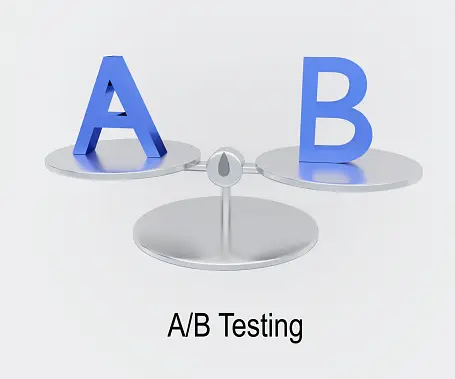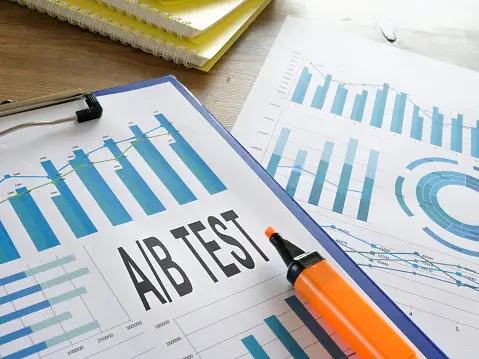Title: A/B Testing Ad Copy and Landing Pages: Tips for Optimization
In the world of digital advertising, A/B testing is a tried-and-true method for optimizing ad copy and landing pages to maximize engagement, conversions, and ROI. By systematically comparing different versions of your ads and landing pages, you can identify what resonates best with your audience and make data-driven decisions to improve performance. In this blog post, we’ll explore the importance of A/B testing, best practices for conducting tests, and tips for optimizing your ad copy and landing pages.

Understanding A/B Testing:
A/B testing, also known as split testing, involves creating two or more variations of a marketing asset (such as ad copy or a landing page) and comparing their performance to determine which version performs better. The variations are randomly presented to users, and their interactions are tracked to measure key performance metrics such as click-through rate (CTR), conversion rate, and bounce rate.
Why A/B Testing Matters:
A/B testing is essential for optimizing your digital advertising efforts for several reasons:
- Data-Driven Decision Making: A/B testing provides empirical evidence of what works and what doesn’t, allowing you to make informed decisions based on real user data rather than assumptions or guesswork.
- Continuous Improvement: By systematically testing and iterating on your ad copy and landing pages, you can gradually refine your marketing assets over time, leading to incremental improvements in performance.
- Maximized ROI: Optimizing your ad copy and landing pages through A/B testing can lead to higher CTRs, conversion rates, and ultimately, better ROI on your advertising spend.
Best Practices for A/B Testing:
Here are some best practices to keep in mind when conducting A/B tests for your ad copy and landing pages:
- Define Clear Objectives: Before conducting any tests, clearly define the objectives you want to achieve. Whether it’s increasing CTR, improving conversion rates, or reducing bounce rates, having clear goals will help you design meaningful experiments.
- Test One Variable at a Time: To accurately isolate the impact of specific changes, it’s important to test one variable at a time. Whether it’s the headline, body copy, call-to-action (CTA), or layout, focus on testing individual elements to pinpoint what drives performance improvements.
- Use Statistical Significance: Ensure that your tests have a large enough sample size to yield statistically significant results. Tools like Google Optimize or Optimizely can help calculate statistical significance and determine when to conclude a test.
- Test Both Small and Bold Changes: While small tweaks like adjusting the wording of a headline can sometimes lead to significant improvements, don’t be afraid to test more radical changes as well. Experiment with different messaging strategies, visual elements, and offers to uncover what resonates best with your audience.
- Monitor Performance Metrics: Throughout the testing process, closely monitor key performance metrics to track the impact of your variations. Keep an eye on metrics such as CTR, conversion rate, average session duration, and bounce rate to evaluate the effectiveness of each test.

Tips for Optimizing Ad Copy:
When A/B testing ad copy, consider the following tips to maximize effectiveness:
- Craft Compelling Headlines: Experiment with different headline formats, lengths, and messaging angles to grab users’ attention and entice them to click.
- Test Different Messaging Strategies: Try different value propositions, offers, and calls-to-action to see which resonates best with your target audience.
- Use Emotional Appeals: Experiment with emotional triggers such as fear, curiosity, or urgency to evoke a response from users.
- Highlight Unique Selling Points: Showcase what sets your product or service apart from competitors and why users should choose your offering.
Tips for Optimizing Landing Pages:
When A/B testing landing pages, consider the following tips to improve user engagement and conversion rates:
- Simplify the Design: Test different layouts, color schemes, and visual elements to create a clean and intuitive user experience.
- Optimize for Mobile: Ensure that your landing pages are fully responsive and load quickly on mobile devices to accommodate users browsing on smartphones and tablets.
- Streamline the Conversion Process: Remove distractions and unnecessary form fields to make it as easy as possible for users to complete the desired action.
- Test Different Calls-to-Action: Experiment with variations of your CTA button text, color, size, and placement to encourage more conversions.
- Incorporate Social Proof: Testimonials, reviews, and trust badges can help build credibility and trust with users, increasing their likelihood of converting.
Conclusion:
A/B testing is a powerful tool for optimizing ad copy and landing pages to improve performance and achieve better results from your digital advertising efforts. By following best practices, testing both small and bold changes, and monitoring key performance metrics, you can systematically refine your marketing assets over time and maximize the effectiveness of your campaigns. Whether you’re tweaking ad headlines, testing different messaging strategies, or optimizing landing page layouts, A/B testing empowers you to make data-driven decisions that drive better engagement, conversions, and ROI.
Incorporate Multivariate Testing for Deeper Insights:

While A/B testing allows you to compare two variations of a single element, multivariate testing takes experimentation to the next level by simultaneously testing multiple combinations of elements within an ad or landing page. This approach enables you to uncover interactions between different variables and identify the most impactful combinations for optimal performance. For example, you could test variations of both headlines and CTAs simultaneously to determine which combination yields the highest conversion rate. Multivariate testing requires careful planning and analysis but can provide valuable insights into how different elements interact and influence user behavior.
Leverage Seasonal and Trend-Based Testing:
Consider incorporating seasonal and trend-based testing into your optimization strategy to capitalize on changing consumer preferences and behavior patterns. Test different ad copy and landing page variations tailored to specific seasons, holidays, or trending topics relevant to your target audience. For example, you might run A/B tests on messaging related to Black Friday promotions, summer sales, or current events that resonate with your audience. By aligning your messaging with timely trends and seasonal events, you can increase relevance and engagement, driving higher conversion rates and improving overall campaign performance.
Implement User Feedback and Surveys:
In addition to quantitative data from A/B testing, qualitative insights from user feedback and surveys can provide valuable context and understanding of user preferences and motivations. Incorporate user feedback mechanisms such as surveys, feedback forms, or user testing sessions to gather insights directly from your audience. Ask users about their preferences, pain points, and satisfaction levels with your ad copy and landing pages. Use this feedback to inform your A/B testing hypotheses and prioritize optimization efforts based on user insights. By combining quantitative data with qualitative feedback, you can develop a deeper understanding of user behavior and preferences, leading to more effective optimization strategies.
Continuously Iterate and Evolve:
Optimization is an ongoing process that requires continuous iteration and evolution to stay ahead of changing consumer preferences and market dynamics. Once you’ve identified winning variations through A/B testing, don’t rest on your laurels. Continue to test new hypotheses, experiment with different elements, and refine your strategies based on performance data and user feedback. Set up a structured testing schedule to regularly evaluate and optimize your ad copy and landing pages, ensuring that your campaigns remain effective and competitive over time. By adopting a culture of continuous improvement and experimentation, you can stay agile and adaptive in the ever-evolving landscape of digital advertising.
Conclusion:
A/B testing ad copy and landing pages is a cornerstone of successful digital advertising campaigns, enabling marketers to make data-driven decisions and optimize for maximum impact. By following best practices, incorporating advanced testing techniques, and leveraging user feedback, you can refine your messaging, improve user engagement, and drive higher conversion rates. Whether you’re testing individual elements or conducting multivariate experiments, the key is to remain proactive, iterative, and responsive to the evolving needs and preferences of your audience. With a strategic approach to A/B testing and a commitment to continuous optimization, you can unlock the full potential of your digital advertising efforts and achieve measurable success in your marketing campaigns.
Harnessing AI-Powered Personalization:
Take your A/B testing efforts to the next level by incorporating AI-powered personalization techniques. Machine learning algorithms can analyze user behavior, preferences, and demographics to deliver highly tailored ad copy and landing page experiences. Experiment with dynamic ad copy and content variations that automatically adapt based on individual user characteristics, such as location, browsing history, or purchase intent. By personalizing your messaging to resonate with each user’s unique interests and needs, you can increase relevance and engagement, driving higher conversion rates and improving overall campaign performance.
Explore Advanced Testing Platforms and Tools:
As the field of digital marketing evolves, so too do the tools and platforms available for A/B testing and optimization. Explore advanced testing platforms and tools that offer sophisticated features such as audience segmentation, automated testing, and predictive analytics. Platforms like Optimizely, VWO, or Google Optimize provide robust capabilities for designing, executing, and analyzing A/B tests with greater efficiency and accuracy. Experiment with different testing methodologies, such as bandit testing or Bayesian testing, to uncover insights and optimize your campaigns more effectively. By leveraging advanced testing platforms and tools, you can streamline your optimization process and unlock deeper insights into user behavior and preferences.
Incorporate Cross-Channel Optimization:
Extend your A/B testing efforts beyond individual channels to encompass cross-channel optimization strategies. Test variations of your ad copy and landing pages across multiple channels and devices to ensure consistency and coherence in your messaging. Experiment with different cross-channel attribution models to understand how users interact with your brand across various touchpoints and channels. By optimizing your messaging and user experience holistically across channels, you can create a seamless and cohesive brand experience that resonates with users at every stage of the customer journey.
Collaborate Across Departments and Teams:

Optimization is a collaborative effort that requires alignment and cooperation across departments and teams within your organization. Work closely with your marketing, design, and development teams to ideate, execute, and analyze A/B tests effectively. Involve stakeholders from different departments in the testing process to gain diverse perspectives and insights. Encourage cross-functional collaboration and knowledge sharing to foster a culture of experimentation and innovation. By leveraging the collective expertise and resources of your organization, you can accelerate the pace of optimization and drive meaningful results in your digital advertising campaigns.
Conclusion:
A/B testing ad copy and landing pages is a dynamic and iterative process that requires strategic planning, experimentation, and collaboration. By harnessing advanced techniques such as AI-powered personalization, exploring cutting-edge testing platforms and tools, incorporating cross-channel optimization strategies, and fostering collaboration across departments and teams, you can elevate your optimization efforts to new heights. Continuously iterate and refine your testing strategies based on data-driven insights and user feedback, and you’ll be well-positioned to achieve measurable success in your digital advertising campaigns. With a proactive and collaborative approach to A/B testing, you can unlock the full potential of your marketing efforts and drive meaningful results for your business.
Conduct In-Depth Competitive Analysis:
Gain valuable insights and inspiration by conducting thorough competitive analysis as part of your A/B testing strategy. Study your competitors’ ad copy, messaging tactics, and landing page designs to identify strengths, weaknesses, and areas for differentiation. Analyze their A/B testing methodologies and outcomes to learn from their successes and failures. By understanding what resonates with your competitors’ audiences and where they may be falling short, you can inform your own testing hypotheses and strategies for optimization. Keep a close eye on competitor activity and adjust your testing approach accordingly to maintain a competitive edge and stay ahead of the curve.
Implement Seasonal and Trend-Based Testing:
Incorporate seasonal and trend-based testing into your optimization strategy to capitalize on emerging opportunities and seasonal trends. Tailor your ad copy and landing page messaging to align with holidays, events, or cultural moments that are relevant to your audience. Test different variations that reflect seasonal themes, promotions, or offers to determine what resonates best with your target audience during specific times of the year. By staying agile and responsive to seasonal trends and cultural shifts, you can maximize relevance and engagement, driving higher conversion rates and improving overall campaign performance.
Utilize Customer Journey Mapping:
Map out the customer journey from awareness to conversion to identify key touchpoints and opportunities for optimization. Consider how users interact with your ads and landing pages at each stage of the journey and tailor your testing hypotheses accordingly. Test variations of your ad copy and landing pages that cater to users’ needs, preferences, and pain points at different stages of the customer journey. Use insights from customer journey mapping to inform your testing strategies and prioritize optimization efforts where they’ll have the greatest impact on driving conversions and improving the overall user experience.
Leverage User Segmentation and Personalization:
Segment your audience based on demographics, behaviors, and preferences to deliver personalized ad experiences that resonate with different user segments. Test variations of your ad copy and landing pages tailored to specific audience segments to increase relevance and engagement. Experiment with dynamic content and personalized messaging that speaks directly to users’ interests, needs, and purchase intent. By leveraging user segmentation and personalization, you can create more meaningful and impactful ad experiences that drive higher conversion rates and improve overall campaign performance.
Conclusion:
A/B testing ad copy and landing pages is a dynamic and multifaceted process that requires strategic planning, experimentation, and analysis. By incorporating advanced techniques such as competitive analysis, seasonal and trend-based testing, customer journey mapping, user segmentation, and personalization, you can elevate your optimization efforts and drive meaningful results in your digital advertising campaigns. Continuously iterate and refine your testing strategies based on data-driven insights and user feedback, and you’ll be well-positioned to achieve measurable success and outperform competitors in the ever-evolving landscape of digital marketing. With a proactive and strategic approach to A/B testing, you can unlock the full potential of your marketing efforts and drive sustainable growth for your business.
Harness the Power of Emotional Triggers:
Experiment with incorporating emotional triggers into your ad copy and landing pages to evoke a strong response from your audience. Test variations that appeal to emotions such as fear, joy, curiosity, or urgency to capture users’ attention and drive engagement. Consider how your product or service can fulfill users’ emotional needs or address their pain points, and craft messaging that resonates on an emotional level. By tapping into users’ emotions, you can create a more compelling and persuasive ad experience that encourages them to take action and convert.
Test Different Visual Elements:
Don’t overlook the importance of visual elements in your ad copy and landing pages. Test different images, graphics, videos, and other visual assets to see how they impact user engagement and conversion rates. Experiment with different formats, styles, and placements to find the most effective combinations for your audience. Pay attention to factors such as color schemes, imagery relevance, and visual hierarchy to create visually appealing and impactful ad experiences. By testing and optimizing visual elements, you can enhance the overall effectiveness of your ad campaigns and improve user engagement.
Optimize for Voice Search and Conversational Interfaces:
With the rise of voice search and conversational interfaces, it’s important to optimize your ad copy and landing pages for these emerging technologies. Test variations of your ad copy that are tailored to voice search queries and conversational interactions, using natural language and long-tail keywords. Experiment with different phrasings and question formats to align with how users speak and interact with voice-enabled devices. Similarly, optimize your landing pages to provide concise, conversational responses to common user queries and intents. By optimizing for voice search and conversational interfaces, you can improve the relevance and effectiveness of your ad campaigns in an increasingly voice-driven world.

Conduct Post-Conversion Testing:
Extend your A/B testing efforts beyond the initial click or conversion to evaluate the post-conversion experience and optimize for long-term engagement and retention. Test variations of your post-conversion pages, such as thank-you pages or confirmation pages, to enhance the user experience and encourage further interaction or engagement. Experiment with different messaging, offers, or calls-to-action on post-conversion pages to drive additional conversions or upsells. By optimizing the entire conversion funnel, from ad click to post-conversion engagement, you can maximize the value of each user interaction and improve overall campaign performance.
Conclusion:
A/B testing ad copy and landing pages is a dynamic and iterative process that requires creativity, experimentation, and strategic thinking. By incorporating advanced techniques such as emotional triggers, visual optimization, voice search optimization, and post-conversion testing, you can elevate your optimization efforts and drive meaningful results in your digital advertising campaigns. Continuously iterate and refine your testing strategies based on data-driven insights and user feedback, and you’ll be well-positioned to achieve measurable success and outperform competitors in the competitive landscape of digital marketing. With a proactive and innovative approach to A/B testing, you can unlock the full potential of your marketing efforts and drive sustainable growth for your business.